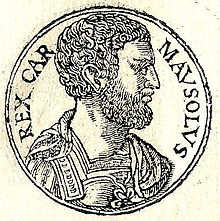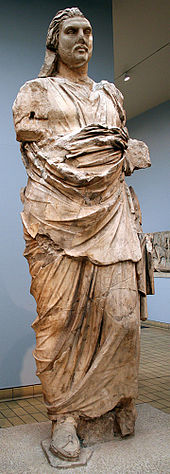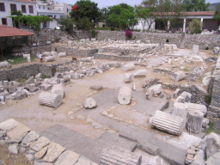- Mausolus
-
Mausolus 
Mausolus from Guillaume Rouillé's Promptuarii Iconum Insigniorum (Lyon, 1555) Satrap of Caria Reign 377–353 BC Predecessor Hecatomnus Successor Artemisia II Consort Artemisia II House Hecatomnids Father Hecatomnus Mausolus (Greek: Μαύσωλος or Μαύσσωλλος) was ruler of Caria (377–353 BC). He took part in the revolt against Artaxerxes Mnemon (362 BC), conquered a great part of Lycia, Ionia and several Greek islands and cooperated with the Rhodians in the Social War against Athens. He moved his capital from Mylasa – the ancient seat of the Carian kings – to Halicarnassus.
Mausolus was the eldest son of Hecatomnus, a native Carian who became the satrap of Caria when Tissaphernes died, around 395 BC. These Carian rulers, the Hecatomnids, embraced Hellenic culture. He is best known for the monumental shrine, the Mausoleum of Mausolus, erected for him by order of his sister and widow Artemisia; Antipater of Sidon listed the Mausoleum as one of the Seven Wonders of the Ancient World. The architects Satyrus and Pythis, and the sculptors Scopas of Paros, Leochares, Bryaxis and Timotheus, finished the work after the death of Artemisia, some of them working, it was said, purely for renown. The site and a few remains can still be seen in the Turkish town of Bodrum.
The term mausoleum has come to be used generically for any grand tomb.
An inscription discovered at Milas, the ancient Mylasa,[1] details the punishment of certain conspirators who had made an attempt upon his life at a festival in a temple at Labranda in 353.
Literature
- Simon Hornblower: Mausolus, Clarendon Press, Oxford 1982
External links
References
- ^ Published by Philipp August Böckh, CIG ii. 2691 c.
 This article incorporates text from a publication now in the public domain: Chisholm, Hugh, ed (1911). Encyclopædia Britannica (11th ed.). Cambridge University Press.
This article incorporates text from a publication now in the public domain: Chisholm, Hugh, ed (1911). Encyclopædia Britannica (11th ed.). Cambridge University Press.
Categories:- 353 BC deaths
- 352 BC deaths
- Carian people
- Satraps
Wikimedia Foundation. 2010.



